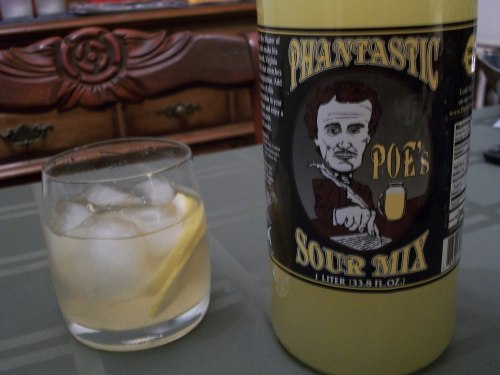
- 6 parts gin (3 oz.)
- Dry vermouth (1/4 tsp. or less)
- Cocktail olive (or lemon twist in this case)
New York Bartender’s Guide
No drink in the history of bartending has been so unanimously
extolled and yet so frequently made the subject of controversy. The
Martini has too many variations to count, and every bartender claims to
have the secret to making the perfect Martini. Some recipes even exceed
the liberal definition that this bartender allows for the use of the
sacred name. Martinis range from shaken or stirred, to olive or lemon
(or onion), to dry to wet to dirty, and up or on the rocks. Martinis can
even make use of gin or vodka and can include liqueurs like Dubonnet
Rouge, Midori, Chambord, Drambuie, and Campari. So what do they all have
in common?
Martini purists say that the original Martini was made with gin.
Others allow that it is only a Martini if it also includes a percentage
of vermouth, no matter how small. I am inclined to agree with the latter
since I like a vodka Martini (pictured above) and I agree that scenting
a martini with a liqueur is sometimes a excellent way to make a
distinguishing flourish on a classic cocktail. Once a Martini strays
into using other spirits like rum, whiskey or tequila as the main
ingredient, you are stepping on another cocktail’s territory and the
drink requires a new name. That is why we have the Manhattan, the Black
Dog, and the Cosmo to differentiate between cocktails served up and true
Martinis. I tend to draw the line when someone adds a significant
portion of non alcoholic fruit juice (cranberry for the aptly named
Cosmo and pineapple for the French Martini—which I wouldn’t call a real
Martini). To me, a Martini means a stiff (strong) cocktail, and fruit
juice defeats this end by watering the drink down. Liqueurs don’t tend
to do this and they rarely make up a large percentage of the drink.
That said, Martini originalists are quick to point out that early
forms of the drink date back to the American Prohibition when people
were accustomed to drinking chilled vermouth straight. Martinis then
were mostly vermouth (6 parts vermouth to 3 parts gin) owing to the poor
quality of the gin versus the availability of homemade vermouth. The
gin was added to give strength to an already potent glass of fortified
wine because who knew when your drinking party might be interrupted by
the prohibition officers
Martinis nowadays display gin or vodka as their main feature; they
are spicy drinks with citrus twists or briny drinks with pickle, onion
or olive garnishes. At least with these variations, the drinker has some
idea of what to expect. Vermouth is used in smaller and smaller
quantities (a single drop in the glass or in the ice before shaking) and
is sometimes omitted altogether.
What most bartenders agree on is that a Martini is served cold and
consumed quickly to prevent it from warming up. The cocktail glass
provides a large surface to allow the drinker to sniff the concoction
while drinking, but drinking on the rocks is easier if you need to stand
or walk with your drink (or you want to let the ice melt longer and
extend your sipping time.) All bartenders should tailor their Martini to
the drinker’s specifications.
Ask the following questions before making:
Vodka or gin?
Dry or dirty or sweet?
Up or rocks?
Shaken or stirred?
Olive or twist?
That’s a lot of to talk about, but you don’t want to disappoint. Good
bartenders are able to make a Martini the way each individual enjoys
them: a good bartender is not someone who only makes one kind of
Martini—their own standard of perfection. You’ll end up throwing away a
lot of perfect drinks if you do this.





































